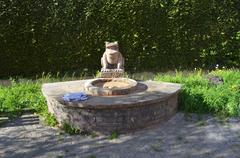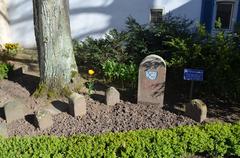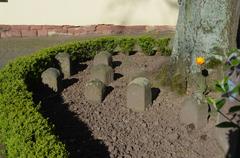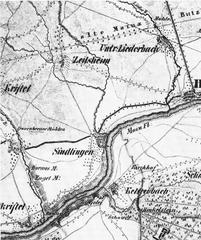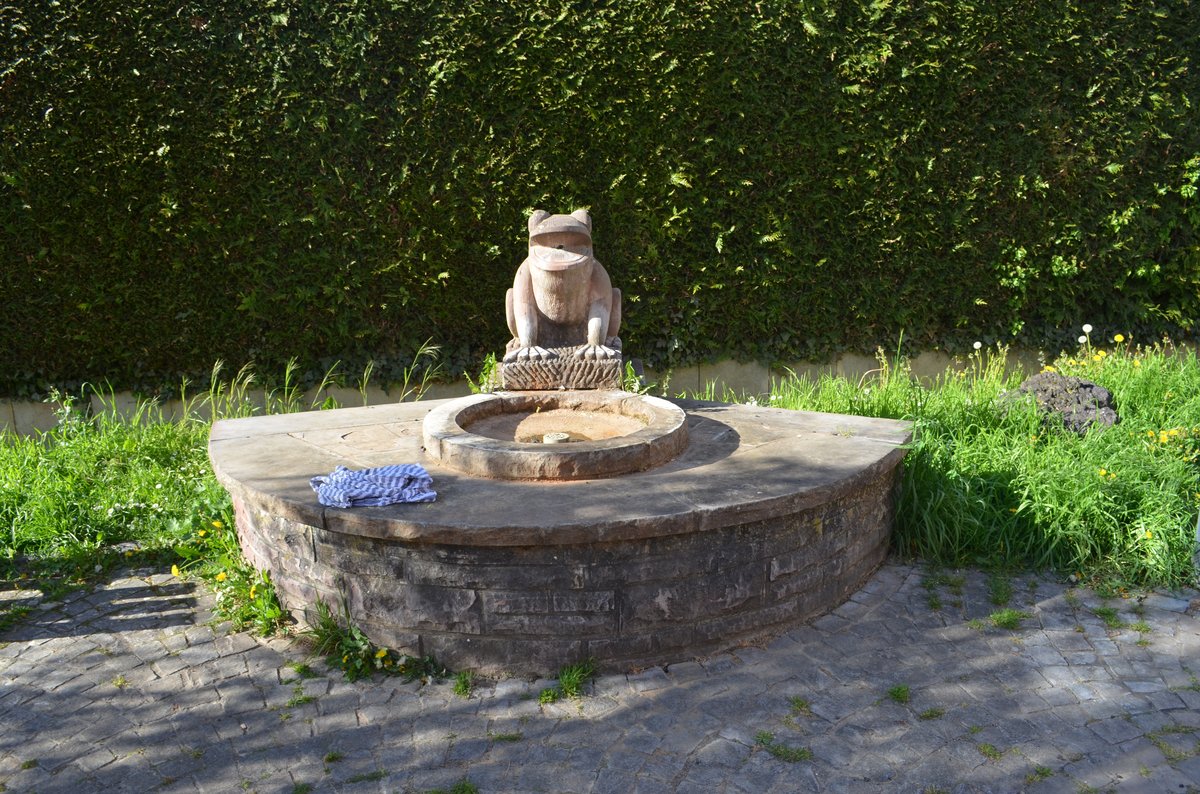
Zeilsheim Frankfurt: Historical Sites, Visiting Hours, and Tickets Guide
Date: 14/06/2025
Introduction
Zeilsheim, on the western edge of Frankfurt am Main, is a district where layers of history, architectural charm, and a vibrant community coalesce. With origins dating back to 794 CE—when it was first recorded as “Ciolfesheim”—Zeilsheim has evolved from a medieval agricultural village to a hub of industrial growth, shaped by its association with Hoechst AG, and later played a crucial role as one of Germany’s largest Jewish Displaced Persons (DP) camps after World War II. Today, Zeilsheim’s unique blend of past and present is evident through its heritage sites, green spaces, and lively festivals.
This comprehensive guide details Zeilsheim visiting hours, ticketing information, travel tips, historical context, and nearby attractions. Whether you’re a history enthusiast, a family traveler, or simply curious about Frankfurt’s lesser-known districts, Zeilsheim offers a rewarding experience. For further information, see Frankfurt Tipp, the USHMM Encyclopedia, and local insights from Der Frankfurter.
Table of Contents
- Introduction
- Historical Overview of Zeilsheim
- Visitor Information: Hours, Tickets, Accessibility
- Guided Tours, Events, and Photographic Spots
- Travel Tips
- Nearby Attractions
- Frequently Asked Questions (FAQ)
- Conclusion and Resources
Historical Overview of Zeilsheim
Medieval Beginnings and Rural Heritage
Zeilsheim’s first mention in 794 CE as “Ciolfesheim” marks it as one of the oldest settlements near the Main River (Frankfurt Tipp). Initially a fertile agricultural village, Zeilsheim’s rural character is still visible in its village core, where half-timbered houses and cobblestone streets evoke its medieval past.
Industrialization and Urban Growth
The late 19th and early 20th centuries brought transformation as Zeilsheim became part of the industrial expansion driven by the nearby Hoechst chemical works. The “Zeilsheimer Kolonie,” an Art Nouveau (Jugendstil) workers’ settlement built in 1899, stands today as a heritage-protected district, reflecting early examples of socially conscious urban planning (Wikipedia).
Incorporation into Frankfurt
After being annexed to Höchst in 1917, Zeilsheim became part of Frankfurt in 1928, cementing its role as both a residential and industrial district (Wikipedia).
World War II and the Displaced Persons Camp
In the aftermath of World War II, Zeilsheim hosted one of Germany’s largest Jewish DP camps, which by October 1945 sheltered over 5,500 survivors. The camp fostered a vibrant community with its own synagogue, schools, and cultural organizations, and was visited by prominent figures such as David Ben-Gurion and Eleanor Roosevelt (USHMM Encyclopedia). The DP camp closed in 1948, but its legacy is preserved through local memorials and exhibitions.
Modern Zeilsheim
Today, Zeilsheim is home to about 12,000 residents, divided into Nord, Süd, and West sub-districts. It features lively local associations, annual festivals, and accessible public amenities, all woven into its historical fabric (Der Frankfurter).
Visitor Information: Hours, Tickets, Accessibility
Heimatmuseum Zeilsheim
- Location: Former fire station on Pfaffenwiese
- Visiting Hours: Wednesdays and Saturdays, 2:00 PM – 5:00 PM
- Tickets: Free admission; donations appreciated
- Guided Tours: Available for groups by appointment via the Heimat- und Geschichtsverein
- Accessibility: Wheelchair accessible
The Heimatmuseum Zeilsheim, often called “Frankfurt’s smallest but most beautiful museum,” displays rotating exhibitions on local history, including the DP camp, industrial heritage, and everyday life. It also serves as a hub for local clubs to showcase their histories (Der Frankfurter).
Zeilsheimer Kolonie (Heritage Worker Settlement)
- Visiting Hours: Self-guided tours available year-round; public spaces open at all times
- Tickets: No admission fee
- Guided Tours: Book in advance with the Heimat- und Geschichtsverein
The Kolonie’s Jugendstil semi-detached brick homes and gardens, plus the church built in 1912, are highlights for architecture enthusiasts.
Displaced Persons Camp Memorial
- Location: Bechtenwaldpark, behind Stadthalle
- Hours: Accessible daily during daylight hours
- Tickets: Free
- Accessibility: Paved paths suitable for wheelchairs
- Events: Annual commemorations on Holocaust Remembrance Day
Informational boards and a memorial plaque invite reflection on Zeilsheim’s important postwar history (USHMM Encyclopedia).
Guided Tours, Events, and Recommended Photo Spots
Guided Tours
- Themes: DP camp history, industrial heritage, Märchensiedlung, and architectural walks
- Booking: Contact local history association or Zeilsheim district office for schedules
Festivals & Community Events
- Froschbrunnenfest: Annual summer festival centered around the Frog Fountain, featuring music, food, and games
- Zeilsheimer Nachmittag and Christmas Market: Community gatherings with cultural programs
Photographic Spots
- Märchensiedlung’s fairy-tale architecture
- Pfaffenwiese avenue, especially with blooming chestnut trees
- St. Bartholomäus Church interior and exterior
- Zeilsheimer Kolonie’s Art Nouveau houses
Travel Tips
- Getting There: S-Bahn S2 from Frankfurt Hauptbahnhof to Zeilsheim (every 30 minutes); several bus lines also serve the district
- By Car: Easily reached via the A66 motorway
- Cycling: Flat terrain and dedicated cycling paths make Zeilsheim ideal for biking
- Best Time to Visit: Spring and early autumn for pleasant weather and local festivals
- Language: German is prevalent, but English is understood at major sites
- Dining: Enjoy traditional Hessian cuisine at local taverns and cafés
Nearby Attractions
- Frankfurt-Höchst Old Town: Medieval streets, the historic Schloss Höchst, and riverfront promenades
- Nidda Valley People’s Park (Volkspark Niddatal): Expansive green space for hiking, cycling, and picnicking
- Frankfurt City Center: Museumsufer, Römerberg, and Main Tower are easily accessible by public transit
Frequently Asked Questions (FAQ)
Q: What are the Heimatmuseum Zeilsheim’s opening hours?
A: Wednesdays and Saturdays, 2:00 PM – 5:00 PM.
Q: Is there an admission fee for the museum or memorial?
A: No; both are free to visit.
Q: Are guided tours available?
A: Yes, group tours can be arranged in advance.
Q: How do I get to Zeilsheim from Frankfurt Hauptbahnhof?
A: Take S-Bahn S2 directly to Zeilsheim station.
Q: Is Zeilsheim accessible for visitors with disabilities?
A: Yes, most sites and transport are wheelchair accessible.
Q: Can I participate in local festivals or club events?
A: Many events are open to guests; check with individual clubs or local websites for details.
Conclusion
Zeilsheim is a distinctive destination that invites you to experience the intersection of history, culture, and community spirit. From the poignant memorials and heritage architecture to vibrant festivals and accessible green spaces, Zeilsheim offers a rewarding journey into one of Frankfurt’s most storied districts.
For the latest updates, guided tour schedules, and community events, download the Audiala app and follow our social media channels. Begin your exploration of Zeilsheim—one of Frankfurt’s true hidden gems.
Internal and External Links
Internal:
External:
- Frankfurt Tipp – Zeilsheim
- USHMM Encyclopedia – Zeilsheim DP Camp
- Der Frankfurter – Zeilsheim District
- Frankfurt Tourism Official Site
- Frankfurt-West Borough Page
